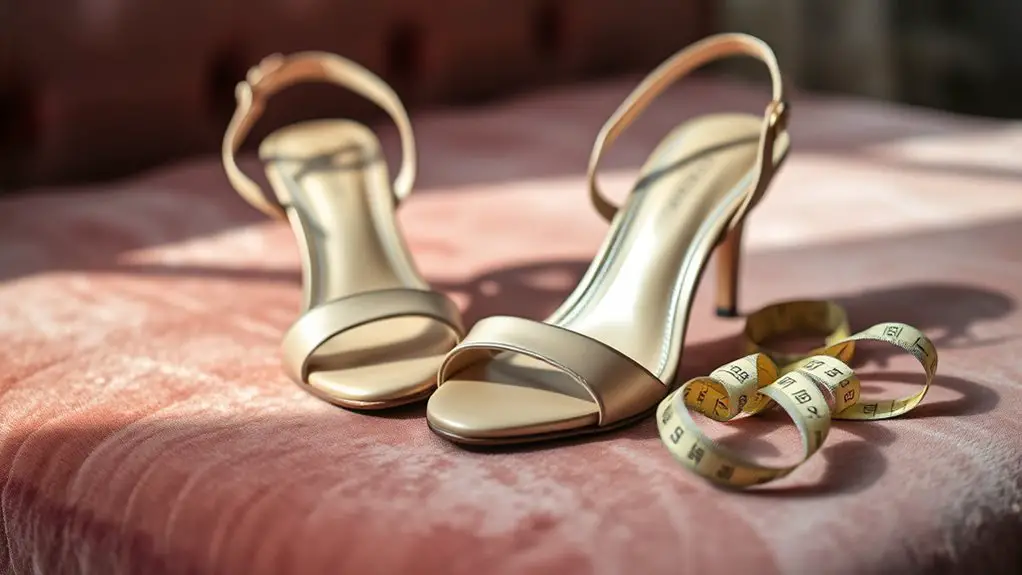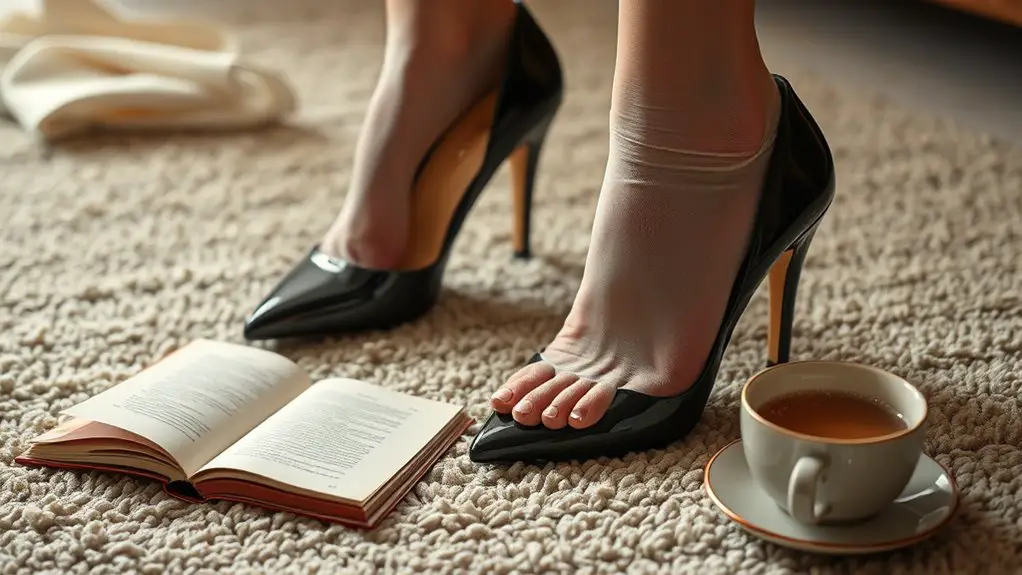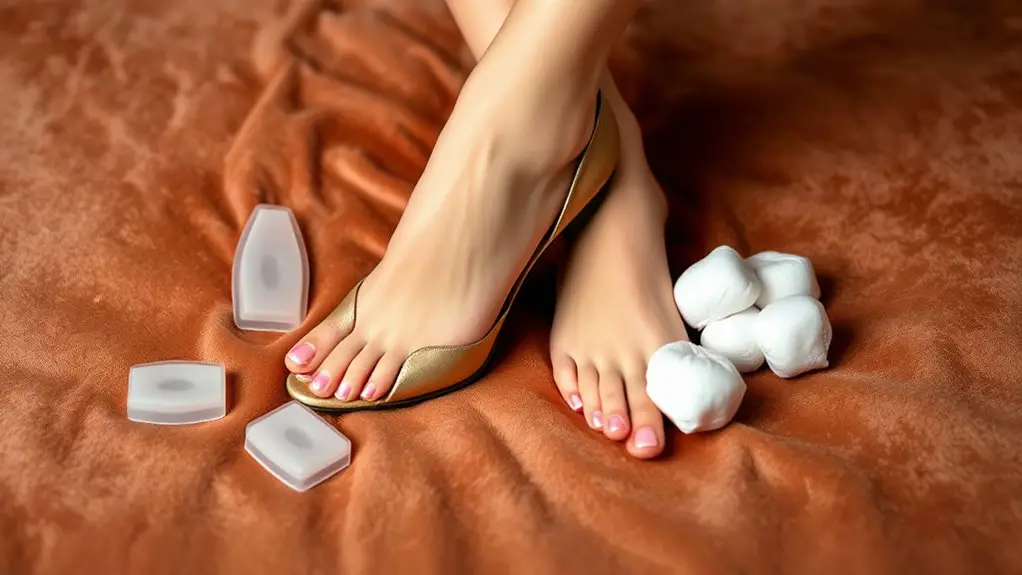To stop heels from hurting your feet, choose the right size and fit, and make sure to opt for cushioned insoles for additional support. Limit your wear time and gradually break in your heels to ease discomfort. Incorporate stretching and strengthening exercises for better foot mobility. Pay attention to heel height that matches your comfort level. By following these steps, you’ll enhance your overall foot health and comfort, leading to a more enjoyable wearing experience.
Choose the Right Size and Fit

Choosing the right size and fit for your heels is crucial to preventing discomfort. Start by taking accurate foot measurements; this means measuring both length and width to guarantee a proper fit. Remember, foot size can change over time, so it’s wise to measure your feet regularly. Different shoe brands may have varying sizing standards, so don’t rely solely on the number on the box. Always try on heels before purchasing, paying attention to how they feel on your feet. When trying them on, walk around the store to check for any pinching or slipping. Opt for styles that accommodate your foot shape; for instance, some brands offer wider options. Finally, consider the heel height and arch support, as these factors considerably affect overall comfort. By focusing on the right size and fit, you’ll minimize discomfort and enjoy wearing your heels more.
Opt for Cushioned Insoles
Even with the right size and fit, heels can still cause discomfort over time. To enhance your foot comfort, consider investing in cushioned insoles. These insoles act as a supportive barrier between your feet and the hard surfaces of your heels, absorbing shock and reducing pressure on sensitive areas.
When selecting cushioned insoles, look for those specifically designed for high heels. They often feature arch support and additional padding that aligns with the natural contours of your foot. This added cushioning helps distribute weight more evenly, which can minimize pain during prolonged wear.
Moreover, many cushioned insoles are made from breathable materials, which can help keep your feet cool and dry. By opting for these insoles, you not only improve your overall comfort but also enhance your balance and posture, making your time in heels more enjoyable.
Limit Wear Time

To reduce discomfort from wearing heels, it’s essential to limit your wear time. Start by gradually increasing the duration you wear them, allowing your feet to adjust without excessive strain. Additionally, plan regular rest breaks to give your feet a chance to recover, helping to prevent pain and fatigue.
Gradual Increase in Duration
While it might be tempting to wear your favorite heels for hours on end, gradually increasing the duration of wear is essential for preventing pain and discomfort. This method not only helps your feet adjust but also enhances your comfort level. You can implement effective heel wearing techniques to manage foot pain by starting with shorter periods and slowly extending them.
| Day | Duration (Hours) | Notes |
|---|---|---|
| Day 1 | 1 | Comfortable fit |
| Day 2 | 1.5 | Slight discomfort |
| Day 3 | 2 | Manageable |
| Day 4 | 2.5 | Begin to feel fatigue |
| Day 5 | 3 | Adjust as needed |
Plan Rest Breaks
After gradually increasing the duration of wearing heels, it’s important to incorporate planned rest breaks to further alleviate discomfort. Establishing a rest schedule can greatly enhance your comfort, allowing your feet to recover. Aim to sit down every hour for at least 10-15 minutes, elevating your feet to improve circulation. During these breaks, adjust your foot positioning by stretching your toes and ankles, which can help relieve tension. Be mindful of how your shoes affect your posture; switching to a more supportive option during breaks can also provide relief. By consciously planning these breaks, you not only reduce pain but also extend your ability to wear heels without compromising your foot health.
Incorporate Stretching and Strengthening Exercises
Incorporating stretching and strengthening exercises into your routine is essential for maintaining foot health and preventing heel pain. Focusing on flexibility can enhance your range of motion, while strengthening your arch muscles supports proper foot alignment. By committing to a daily stretching routine, you can greatly reduce discomfort and improve overall foot function.
Importance of Foot Flexibility
Foot flexibility plays an essential role in preventing discomfort when wearing heels, as it directly impacts your overall foot health and comfort levels. Improved foot mobility allows for better weight distribution, reducing strain on specific areas of your feet. Engaging in regular stretching and strengthening exercises enhances flexibility benefits, making it easier to adapt to the demands of high-heeled shoes. Simple stretches, such as calf raises and toe flexes, can greatly improve your foot’s range of motion. Incorporating these exercises into your routine not only aids in maintaining flexibility but also helps prevent injuries. Remember, healthier feet contribute to a more enjoyable experience in heels, so prioritize your foot flexibility for lasting comfort and performance.
Strengthening Arch Muscles
While you might not realize it, strengthening your arch muscles is essential for maintaining comfort in heels. Strong arches provide better arch support and improve foot alignment, reducing pain and discomfort. Here are some effective exercises to strengthen your arch muscles:
- Towel Scrunch: Place a towel on the floor and use your toes to scrunch it towards you.
- Marble Pick-Up: Use your toes to pick up marbles and place them in a bowl.
- Heel Raises: Stand on the edge of a step and slowly raise and lower your heels.
- Arch Lifts: While seated, keep your toes on the ground and lift your arches as high as possible.
Incorporating these exercises into your routine can greatly enhance your foot strength and overall comfort in heels.
Daily Stretching Routine
To keep your feet comfortable in heels, a daily stretching routine is essential for both flexibility and strength. Incorporate dynamic stretches into your morning routine to improve circulation and reduce tension. Start with ankle circles and calf raises to warm up the muscles. Next, try toe stretches and plantar flexor stretches to enhance flexibility. Include strengthening exercises like toe curls with a towel, which can help support your arches. Remember to focus on your Achilles tendon by performing wall stretches. Committing to this routine not only prepares your feet for the day ahead but also helps alleviate discomfort from wearing heels. Consistency in these exercises can lead to significant improvements in foot comfort over time.
Select the Right Heel Height
Choosing the right heel height can make all the difference in your comfort and overall experience. When selecting heels, it’s essential to balance your style preference with the impact on your feet. Here are four key factors to take into account:
Selecting the perfect heel height is crucial for comfort and style; consider occasion, foot shape, duration, and personal comfort.
- Occasion: For casual events, lower heels (1-2 inches) are often more comfortable. For formal settings, you might opt for mid-height (2-3 inches).
- Foot Shape: Reflect on your foot’s arch and width. A wider foot may benefit from lower or block heels, while narrower feet can handle higher styles.
- Duration: If you’ll be on your feet for an extended period, choose a lower heel to reduce strain.
- Personal Comfort: Everyone’s comfort level varies. Try different heights to discover what feels best for you.
Break Them In Gradually

Breaking in new heels is essential for ensuring they don’t cause discomfort during wear. Start by wearing your heels for short periods, gradually increasing the duration over several days. This allows the material to adapt to your feet, enhancing heel flexibility and overall comfort. Pay attention to how the material feels against your skin; softer materials like leather often provide better comfort than stiffer options.
Consider walking on different surfaces to help your feet adjust to varying pressures and angles. If you experience pressure points, try wearing them at home with thick socks to stretch them slightly. Remember, everyone’s feet are unique, so listen to your body. If your heels pinch or cause pain, it might be time to reassess their fit or material comfort. Taking these steps can greatly reduce discomfort and make your new heels a joy to wear instead of a pain.
Explore Foot Care Products
Even after breaking in your heels, discomfort can still arise, making it beneficial to explore various foot care products designed to enhance comfort and support. Consider integrating these essentials into your routine:
Even well-broken-in heels can cause discomfort; explore foot care products to boost comfort and support.
- Foot Creams: Regularly applying moisturizing foot creams can help keep your skin soft, reducing friction and preventing cracks.
- Blister Prevention Stick: This product creates a protective barrier on your skin, minimizing the risk of blisters when wearing heels for extended periods.
- Gel Inserts: These provide extra cushioning and arch support, making your heels feel more comfortable while you walk.
- Metatarsal Pads: Placing these pads in your shoes can alleviate pressure on the balls of your feet, preventing pain during prolonged wear.
Frequently Asked Questions
Are All Heel Types Equally Harmful to Feet?
Not all heel types are equally harmful to your feet; some can feel like torture devices! It’s essential to take into account heel height and design, as they greatly influence your overall foot health and comfort.
How Often Should I Replace My Heels?
You should replace your heels every six to twelve months, depending on usage and heel lifespan. Regularly evaluating their condition guarantees proper support and comfort, preventing potential foot issues associated with worn-out footwear.
Can I Wear Heels During Pregnancy?
You can wear heels during pregnancy, but consider comfort. Many find heel alternatives like flats or low wedges more suitable, as they provide better support and reduce discomfort, ensuring you stay stylish and comfortable throughout your pregnancy.
What Materials Are Best for Comfortable Heels?
When selecting comfortable heels, consider leather options for durability and breathability. Additionally, heels with cushion padding provide extra support, reducing pressure on your feet, making them more enjoyable to wear throughout the day.
Do Orthotics Really Help With Heel Pain?
Orthotics offer outstanding orthotic benefits, providing essential heel support. They can alleviate pressure and improve alignment, making your feet feel fantastic. If you’re struggling with heel pain, consider trying custom orthotics for ideal comfort.



